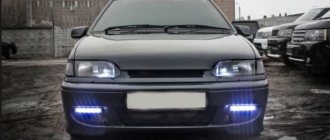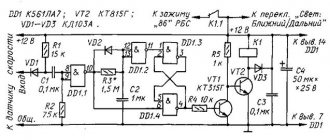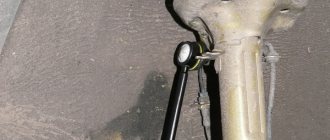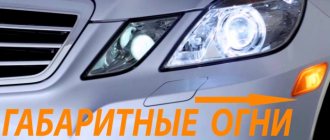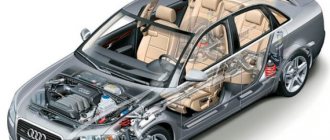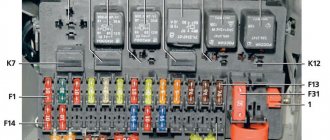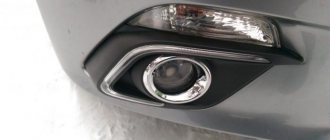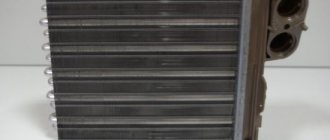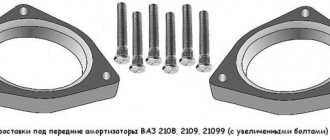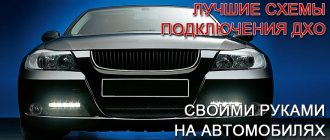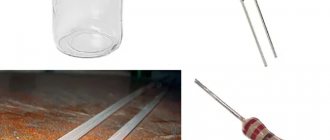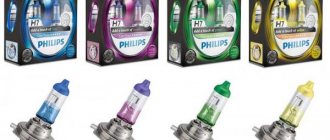Requirements according to the regulations
The new travel requirements regulate the use of either low beam headlights or DRLs, if any, during daylight hours. The use of running lights allows you to extend the life of light sources in car headlights. They also allow you to save battery power or fuel, which is consumed when the headlights are low beam.
The diodes themselves shine in all directions, or rather 120 degrees. To solve this problem, light is focused using optics, mainly lenses. To determine the lens parameters, you need to determine the power, which is measured in Lumens. However, to evaluate performance efficiency, light intensity is measured not in Lumens, but in Candelas. To measure the light intensity of the DRL, you need to place a lux meter in front of the diode at a distance of one meter. In this case, Luxes are converted to Candelas.
Required characteristics for DRL:
- 500 – 700 lumens in each running light;
- power must be at least 6 watts;
- The lighting angle should be 35 degrees.
In addition, DRLs must meet the requirements according to GOST:
- luminous intensity – 400 – 800 Candelas;
- the glow angle should be 25 degrees vertically and 55 degrees horizontally;
- the illuminated area of each of the lights is at least 40 square centimeters;
- light sources should be located at a distance of 25 centimeters from the road surface;
- the distance between the running lights must be at least 60 centimeters;
- The permitted colors of lights are yellow or white.
Use for connecting side lights and low beam headlights
Turning on the DRL from side lights and low beam headlights requires connecting the optics power circuit to the circuit. To do this you need:
- Connect the DRL wire to the positive terminal of the battery.
- Connect the negative wire to the positive of the running lights themselves.
As a result, current will flow from the “+” battery through the LED elements to the side lighting. From them through the spiral of the light bulb to the body, that is, “-” for the entire network. Due to low power consumption, the led elements will be able to glow, while the spiral dimensions will be turned off.
If you turn on the side lights, 12 volts with a “+” sign will appear on their positive contact, the potentials on the DRLs will become equal and the crystals will go out. You can connect in the same way through low beam lamps. The principle of operation will remain the same.
With all the advantages, this method has disadvantages that contradict the traffic rules:
- The XDO lights up when the engine is running.
- If there are LEDs in the side lighting, the circuit will not function.
- With powerful LED elements (comparable in characteristics to incandescent lamps), the system will not turn on.
- A fuse will need to be installed.
Advice! The first minus can be eliminated if the positive wire of the LEDs is connected to the “+” ignition.
Necessary components and assembly of DRLs
Depending on your skills, you can buy ready-made DRLs or make them yourself. The most common components for homemade running lights are cheap fog lights, LED strips, aluminum plates, sealant and a soldering iron. All components must ensure the operation of the DRL in accordance with the requirements and GOSTs. The assembly proceeds as follows:
- An old or purchased fog lamp is disassembled and its filling is taken out.
- Next, a plate is cut from a piece of aluminum to the size of the flashlight body.
- Pieces of either one piece of LED strip or single LEDs are cut to fit the size of the plate.
- After degreasing the plate, a sealant is applied to its surface, to which the LEDs are attached.
- Connecting LEDs or LED strip using a soldering iron with wires.
This is one of the easiest ways to assemble DRLs yourself. There are other assembly methods, which can be found in other sources of information.
What do you need to install DRL yourself?
To install DRL, you need to stock up on the following set of tools:
- Pliers (or wire cutters);
- Soldering iron;
- Lighter;
- Insulated two-core wire;
- Insulated sealed contact;
- Single-core wire (length 3 meters, diameter 1.5–2.5 mm);
- Clamps;
- Relay (12V);
- Actually, a set of daytime running lights;
- Glue, screws, double-sided tape;
- Drill and screwdriver.
After selecting the tools, you need to drive the car to a clean and dry place for installation.
Self-installation of DRLs
Before you start installing DRLs, you need to decide on the location and take measurements. According to the recommended placement of running lights, the distance between them should be at least 60 cm, the minimum and maximum height of placement should be 25 and 150 cm, respectively, and the minimum distance to the headlight should be at least 40 cm. In addition, the running lights themselves should be placed under an angle not exceeding ten degrees so that the illumination complies with GOST standards. The recommended installation location is at the level of the fog lights.
Once the location of the DRLs has been chosen, you can begin installing them on the car. Installation of navigation lights is carried out as follows:
- If they are mounted on a grille, then it must be removed.
- You can attach the DRL using self-tapping screws, or using glue or double-sided tape, having previously degreased the area where it is glued.
- Pull the wires through the clamp hole.
- Install the running lights control unit.
- Connect the wires to the DRL control unit by placing the cables in the special connector.
- Attach the modules and wires in the engine compartment, except for the wires for connecting to the power source, and then finally secure the housing.
Reference! It is not recommended to glue the wiring to the radiator, fuel line or hose. It’s best not to rush into attaching the DRL housing to the car and install it only after all the wires have been routed under the hood.
How to choose DRL?
The requirements that must be taken into account when installing DRLs have already been described above.
If the running lights on your car are not installed correctly, the traffic police inspector will have the right to stop you and issue you a fine. In some situations, the vehicle may even be sent to an impound lot.
If you want your running lights to comply with traffic rules and GOST, you should pay special attention to their selection. After all, a lot will depend on what kind of road running light you decide to install on your car. The highest quality products are produced by companies such as Hella and Philips Osram. It is worth choosing them not only because they meet all the standards, but also because they can make your journey on the roads as safe as possible. There are usually no problems with the products of the brands presented above when the car is diagnosed at a service station. Homemade devices cannot meet all requirements.
Usually there are no difficulties with installing DRLs. The only thing that can cause you inconvenience is a violation of the integrity of the car’s structure. This problem is most common among drivers who bought their car before the law on the mandatory use of DRLs came into force.
If you have an old car that does not have DRLs, then you will have to collect a lot of paperwork to obtain permission to make changes to the vehicle. In addition, you will also have to put in a lot of effort to install running lights. After all, to do this you will have to create holes in the bumper and deal with the electronics.
This is interesting: Rating of the best models of lamps for fog lights
DRL connection diagrams
To complete the installation of DRLs on a car, they need to be connected to a power source and some sensors individually or together, depending on your device.
To speed sensors
Connecting to a speed sensor is one of the simplest methods. The DRL will start when the speed sensor starts. To connect, you need to connect the contacts of the running lights to the break made in the car wiring. For example, at the low beam switch button. Any relay can be used, but it must have an opening pair.
Reference! If you want the lights to work when the car is parked, you need to use a parallel connection.
To oil sensor
Connecting running lights via an oil sensor is convenient because when the car is started, they will light up together with the oil sensor. This will allow you not to think about whether the DRLs were turned on and waste time turning them on and off. The switching circuit is based on switching a four-contact relay. The connection itself occurs as follows:
- Pin 88 is connected to the positive terminals of the DRL.
- Contact 85 is connected to the positive terminals of the dimensions.
- Pin 86 is connected to the oil pressure sensor as a power source.
- Contact 30 goes to the battery positive.
When starting the engine, the oil pressure sensor is turned on, from which the supply voltage for the DRL is supplied and the necessary contacts are closed. This connection is not suitable if LEDs are installed in the dimensions.
Connecting running lights to the generator
The connection to the generator follows the same scheme as in the previous version, except that pin 85 will be connected to the generator and will be triggered when the engine starts.
Connecting the finished kit
In addition to homemade DRLs, you can simply buy ready-made running lights with a control unit. It will provide overload protection, DRL activation after engine start and safe operation. The connection is similar to circuits in which a relay is used, and power is supplied from a generator.
State standard requirements
GOST clearly regulates how DRLs are installed. Installation is considered correct only when the minimum distance from the lights to the ground is 200 millimeters, and the maximum is 1500 millimeters. Between dimensions, the distance cannot be less than 600 millimeters (if the width of the car is less than 1300 millimeters, then this gap is 400 millimeters).
In addition, the rules also describe the principle of operation of lighting equipment. So, the DRL lamps light up simultaneously with the engine starting. Well, such devices should go out when the main lighting fixtures of the car are turned on.
Pros of using DRL
The advantages of using DRLs can be considered using two examples:
- Most cars in use have fairly high power and torque. All this allows them to quickly accelerate to high speeds and perform various maneuvers. If, while one car is performing a dangerous maneuver, the other driver does not notice the vehicle coming towards you, an accident may occur.
- It seems that during the day in the sunshine the car is clearly visible. But the glare from the windows and mirrors of cars coming towards you dulls visibility. In this case, DRL can protect you from an accident.
This is interesting: What are calipers on a car?
Clarifications on the new rules for car tuning from February 1, 2021
In the summer of 2022, a complete transition to electronic PTS is planned. The technical equipment passport will allow you to save all information about motorists in the traffic police databases, which will allow citizens to quickly find out the entire history of the owners when purchasing a used vehicle.
Ad block:
In addition, the convenience of an electronic passport lies in the fact that you can enter more detailed information about the car: maintenance, repairs performed.
In 2022, the Government approved a bill that allows traffic police officers to prosecute drivers who have committed an offense recorded by third parties. Especially for this, in 20148 the “People’s Inspector” application will be announced, through which ordinary eyewitnesses will be able to send information about traffic violations committed by drivers to the traffic police.
In this case, traffic inspectors will not need to draw up decisions to hold the driver accountable for violations of traffic rules and issue a protocol. To punish the perpetrator, it will be sufficient to have a video recording of the violation.
At the beginning of 2022, a new form of compulsory motor third party liability insurance policy will appear, which additionally provides a special code with which you can easily obtain all the information about the contract concluded with the insurance company. All information will be available in real time on the website of the Russian Union of Auto Insurers.
Using this form will allow you to use the application to obtain the following information about the agreement between the insurer and the policyholder:
- Name of the insurance company.
- Series, number and date of issue of the insurance policy.
- Start date and end date of the vehicle use period.
- Information about the policyholder.
- Information about the owner of the insured vehicle.
- Information about persons who are allowed to drive the insured car (list of drivers or an indication of their unlimited circle).
The introduction of this new form is aimed at reducing the number of counterfeit MTPL policies.
The bill being considered by the Government contains amendments stating that compulsory carrier insurance, which is currently taken out by the owners of buses and other public vehicles, must also be provided to taxis.
The law on compulsory carrier liability insurance has been in force in Russia since 2013.
In accordance with the requirements of this regulatory act, the carrier that transports passengers must insure its liability to them.
How to choose running lights
The stores offer a wide selection of DRLs from a variety of manufacturers, in various configurations and colors. However, not every lamp is suitable for use as navigation lights. For example, halogen and xenon lights will not withstand constant operation; they will “eat” a lot of energy and discharge the battery. Incandescent bulbs are also not the best choice, but LEDs are considered the best when installing DRLs.
There are also many LED running lights. The best products are those in glass housings and lensed LED DRLs for foglights. The rest (on rubber bands, “eagle” and “dragon” eyes, in the form of SOV platinums) do not meet the requirements stated by GOST.
Before connecting the daytime running lights yourself, make sure that:
- DRLs match the shape, type and design of your car's bumper.
- The size of the DRL unit, which is selected based on where the running lights will be installed (in the air intake or on the bumper), allows you to mount them in your car.
- The number of LEDs in the block does not exceed 5 pieces for each. If the light is too bright, the daytime lights will shine like “dimensions”, which is unacceptable.
- The luminous intensity of the DRL should be no less than 400 cd and no more than 800 cd, and the temperature range of the lamps should be from 4,300 to 7,000 K.
- Running lights emit pure white light (yellow and blue products are prohibited).
If we talk about manufacturers, then the most reasonable thing would be to purchase a ready-made DRL kit from Hella or Philips. Such units are equipped with everything you need (including a controller) and fully meet the technical requirements. regulations.
Having purchased DRLs for a car, or made them yourself, all that remains is to prepare everything necessary so that the installation of daytime running lights with your own hands goes without “surprises”.
